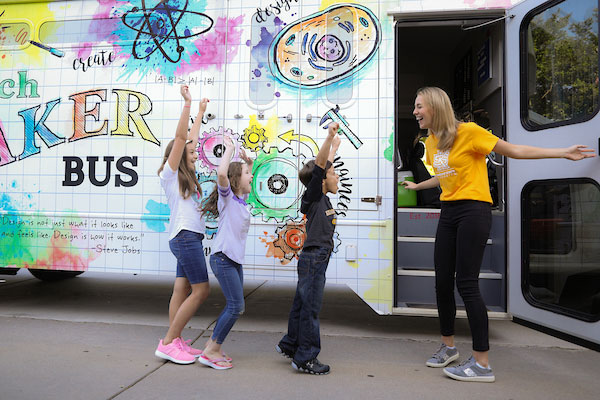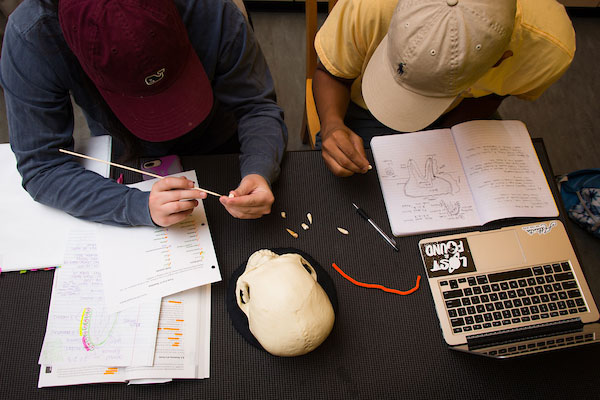|
Frequently Asked Questions
-
My course appears to have been coded as an It's About Engagement (IAE) course, but
I do not think the course fits the definition. Who should I contact?
|
The Banner coding for IAE is handled at the departmental level with college-level coordination. Most colleges have an IAE liaison who works with the Dean and Department Chairs to ensure that the courses in Banner accurately reflect the IAE activity in your college. As a baseline, we have developed specific definitions for
each of the engagement opportunities that we are focusing on for IAE, and you need to ensure that your course meets all of the definition to be coded. A good place to start is to look at the characteristics list for each definition and see that your course meets all of them.
The exact nature of what gets coded and uploaded is a college conversation that can
be had with your administrative chain. Start with your Department Chair, as they were
the original point of contact for the coding, but you may reach out to college liaisons
for additional discussions. You are always welcome to contact the Director of the Quality Enhancement Plan (QEP) if you have questions, but the final decision is a college-level one, so its usually best if you start there.
|
-
My course was not coded as an IAE course, but I think it should have been. Who should
I contact?
|
The Banner coding for IAE is handled at the departmental level with college-level coordination. Most colleges have an IAE liaison who works with the Dean and Department Chairs to ensure that the courses in Banner accurately reflect the IAE activity in your college. As a baseline, we have developed specific definitions for each of the engagement opportunities that we are focusing on for IAE, and you need to ensure that your course meets all of the definition to be coded. A good place to start is to look at the characteristics list for each definition and see that your course meets all of them.
The exact nature of what gets coded and uploaded is a college conversation that can be had with your administrative chain. Start with your Department Chair, as they were the original point of contact for the coding, but you may reach out to college liaisons for additional discussions. You are always welcome to contact the Director of the QEP if you have questions, but the final decision is a college-level one, so its usually best if you start there.
|
-
I have been using engaged learning in my courses for a while. Why do I need to add
a reflection?
|
Reflection is a process whereby students make meaning of their experiences. Engaging
in reflection has numerous benefits for students, such as increasing their confidence,
self-awareness, and ability to make connections across disciplines or between coursework
and personal experiences (e.g., Weber & Myrick, 2018).
Although reflection is less common in undergraduate research than other high-impact educational practices, like service-learning, there is emerging research to suggest that reflective activity helps students process their research experiences more fully and generate new meanings regarding their work. Structured reflection helps students recognize the skills they are developing in the research experience, improving metacognition. In addition, undergraduate researchers report that self-reflection helps them in their applications for post-graduate work (e.g., Nye et al., 2016; Picardo & Sabourin, 2018; Wilson et al., 2016). For more information, see the discussion on Critical Reflection on this website.
References:
- Nye, A., Clark, J., Bidwell, P., Deschamps, B., Frickman, L., & Green, J. (2016).
Writing the (researcher) self: Reflective practice and undergraduate research. Reflective Practice, 17(3), 257–269.
- Picardo, K., & Sabourin, K. (2018). Measuring student learning gains in independent
research experiences in the sciences through reflective practices and ePortfolios. Bioscene, 44(2), 29–36.
- Weber, K., & Myrick, K. (2018). Reflecting on reflecting: Summer undergraduate research students’ experiences in developing electronic portfolios, a meta-high impact practice. International Journal of ePortfolio, 8(1), 13–25.
- Wilson, A., Howitt, S., & Higgins, D. (2016). Assessing the unassessable: Making learning visible in undergraduates’ experiences of scientific research. Assessment & Evaluation in Higher Education, 41(6), 901–916.
|
-
The rubric for the reflections seems to confine the way I teach my engagement course. Does including the reflection in my course limit my academic freedom?
|
The rubric is not intended to constrain you in the building of all of the reflections
in your course. That was never its intent. Remember, the goal of IAE has always been to provide meaningful experiences for all of our students (or, at least, as many as we can manage) and ensure students learn as much as possible in them. In that vein, when you are constructing a good IAE course, you need to do a lot of things to ensure it accomplishes those goals, and
good reflection is one of those things, a key one, but just one. A good reflection
program has many components outlined in the literature, and Center for Excellence in Teaching and Learning (CETL) spends time talking about all of those aspects in their workshops. When a person constructs
a good IAE course, I hope that their reflection process includes all of the things CETL discusses.
The rubric, however, is just an assessment tool to benchmark the student learning
in an IAE experience at a single moment in time. It is not intended that a course will upload
all of the reflections a student does over the course of the semester, just one. That
one should be a culminating moment that allows the student to hit all of the points
of the rubric, but it is up to the faculty member which of the reflection moments
in their class best aligns with the IAE rubric and thus gets submitted. Faculty control the guided prompts they give their
students, which is where providing the rubric can be useful. Each faculty member can
then tailor their prompts to ensure that the student response covers whatever is important
to their course, but it also has within it the qualities IAE is working on tracking in student learning. It is up to the faculty member to ensure its appropriately aligned to their course goals, but also it is written in such a way that the salient information can be assessed by the IAE rubric. For more information, see the discussion on Critical Reflection on this website.
|
-
I was not given any guidance about what the reflection should look like. What am I
supposed to do?
| With a faculty as diverse as that at KSU, guidance for some is viewed as dictatorial fiats from others. As such, there is no mandate about what the reflection assignment needs to look like, and the rubric is provided as a guide. Although the rubric is what will be used to score the reflections for assessment purposes, it is not a roadmap or dictum to force the hand of faculty. The QEP Director has examples available upon faculty request. We have also provided training through CETL for what a good reflection process looks like. If any of your colleagues or even the college want a follow-up training, CETL will be receptive to doing more with the college or even individual departments. For more information, see the discussion on Critical Reflection on this website. |
-
The reflection scoring process looks like another way to evaluate individual faculty
and courses. How are the evaluations being used?
|
IAE, including the attendant instruments, was built by a large swath of the KSU community,
a significant portion of them being fellow faculty members, over the span of a number
of years. As with any project of this scale, it has good stuff in it and some stuff
that can be challenging. Regardless, none of it was written with the intent to evaluate
individual faculty.
To address this point more particularly, when the reflections do get scored, student identifying information will be redacted for individual scorers. Although we do have to track what reflections come from which classes in order to collate the data in the end, the actual reports that are produced will look at scores only down to the college level. So, your individual rubric scores will be averaged in with all of the other scores in the college and will not be identifiable to any of your supervisors for personal evaluation. A lot of this may feel intrusive, because these particular courses rest closer to the core of faculty expertise than just about anything else we do. However, because faculty were involved in the creation of this program and shared your concerns, there is no intent for that to be what happens here, and we have put in place processes to minimize this opportunity, even if a supervisor should be so inclined.
There are only three goals of the IAE:
- To increase the number of opportunities students have for engagement learning (as
defined by internships/coops, research/creative activity, and service-learning);
- To increase the number of students taking advantage of engagement opportunities; and
- To increase the quality of those engagement opportunities as defined by the student
learning that occurs in
them.
None of these goals is really trying to assess how faculty are implementing IAE courses. If that were one of our goals, then we would need a different tool for the job. We do have interviews and focus groups that are happening to assess the IAE process itself, but nothing in IAE is targeting faculty implementation, specifically.
Obviously, faculty implementation will influence student learning in the courses, but that is a step or two removed from the assessment instrument and from the goals of IAE, and so it is not something we are focused on. However, because we certainly understand the linkage between faculty implementation and student learning, IAE counts ourselves lucky to have CETL as an integral partner in this work. All of the staff at CETL are committed to helping faculty figure out the best ways to implement all of the engagement courses and doing so with a deep understanding of the literature. However, they do so from a faculty development role and from a supportive and helpful role that never crosses the line into an evaluation space. For more information, see the discussion on Critical Reflection on this website, as well as CETL's website on faculty development related to IAE.
|
-
Do we need individual student consent to submit the reflections for scoring?
|
There are no consent issues in this process. The reflection is treated like any other internal assessment program and, therefore, does not require IRB supervision. That being said, we will be redacting all identifying information from the reflections when we move them from the submission process to the scoring process. That will give us confidentiality, not anonymity, which is the best we can offer given that we need to be able to track scores to process the data. In the end, the data is not ever about a single student or class. The lowest point of analysis we will be making is at the college level, so all reflections will be combined to give us a college score. When students complete reflections in work places where confidentiality is important, please make sure you work with them to ensure best practices, especially the use of pseudonyms rather than actual names.
The odd start to the IAE coupled with the current pandemic have created large pockets of folk who have still
not received direct communications about things, but this will slowly ebb as we move
things forward. The reality is that the reflection is a core feature of assessing
the student learning goals for the IAE and is a requirement for all IAE-designated courses, and they need to be uploaded, if possible.
|
|
















